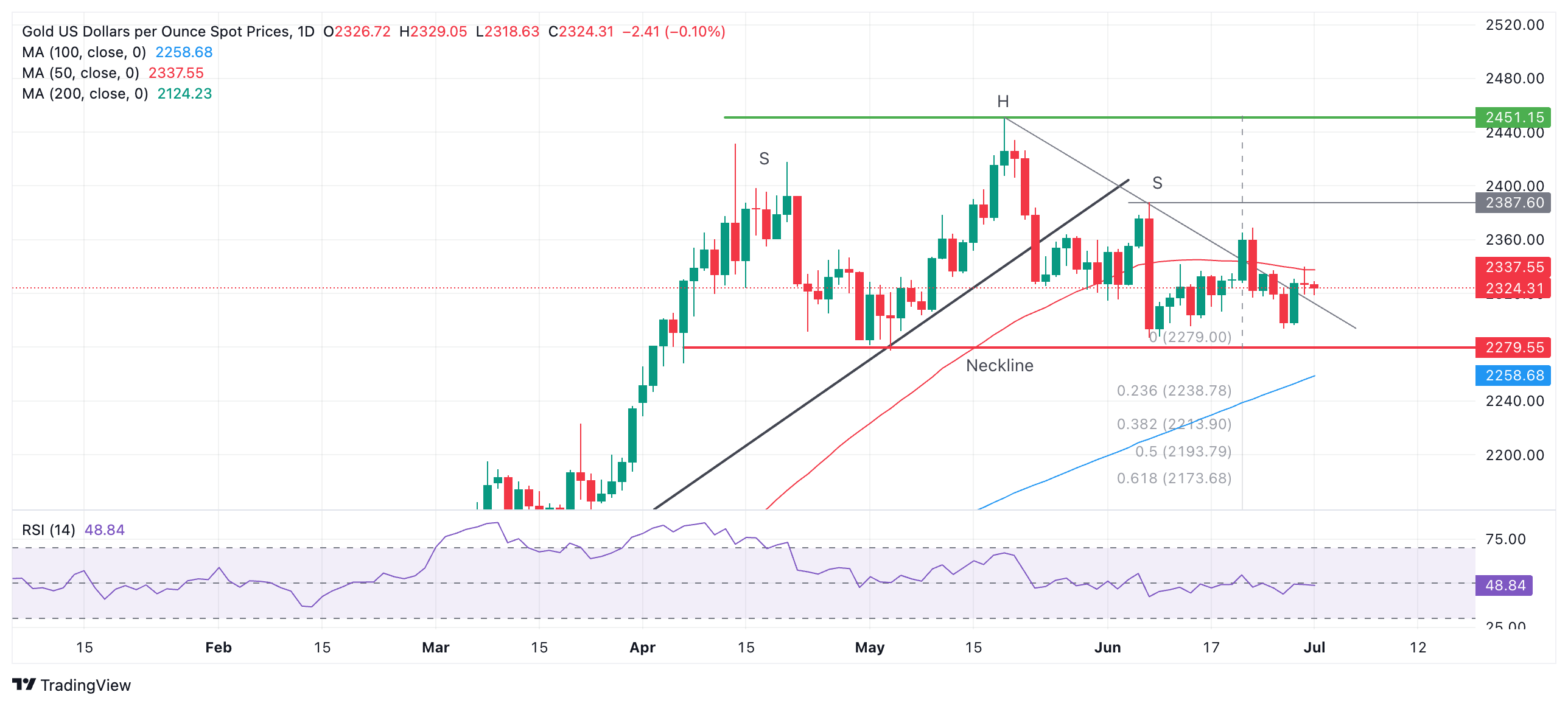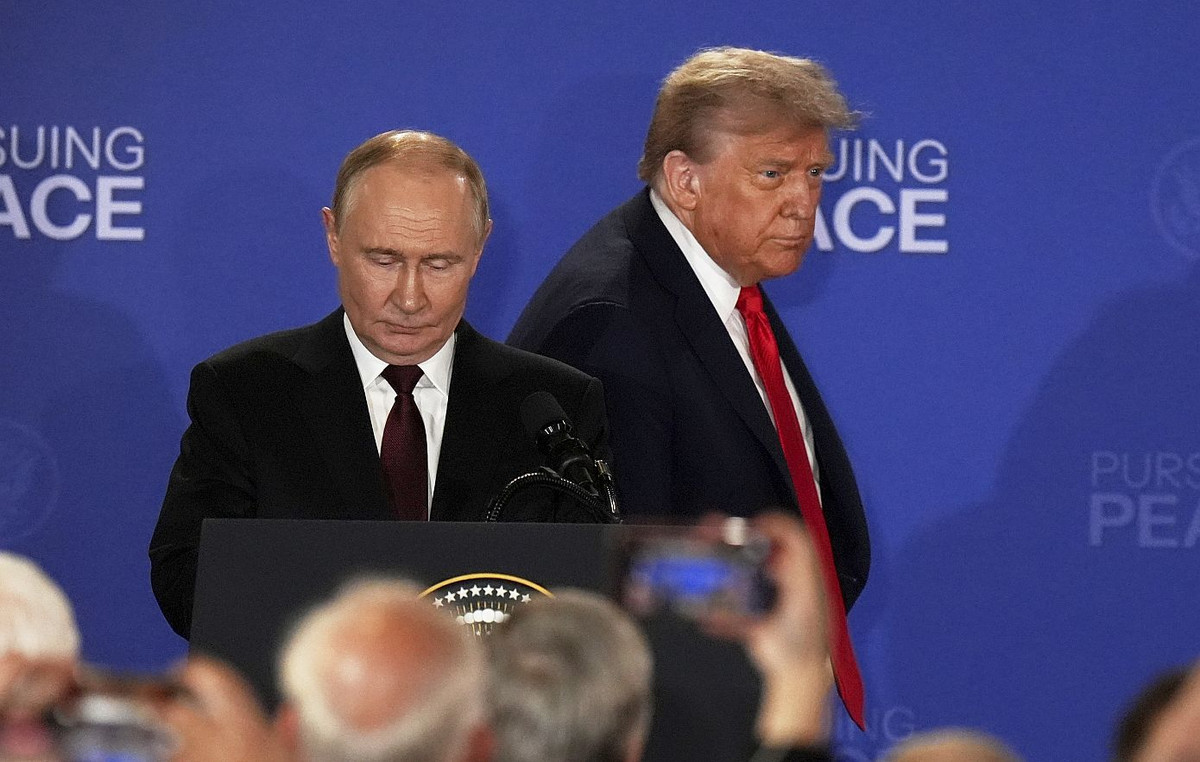- Gold consolidates in a range amid investor uncertainty over when the Fed will cut interest rates.
- Despite falling inflation, Fed officials are reluctant to commit to interest rate cuts.
- XAU/USD is consolidating after breaking above a key trend line, invalidating the bearish head and shoulders pattern that had been forming.
He Gold (XAU/USD) dipped on Monday but still remains within the range it has been in since hitting its all-time high of $2,450 on May 20.
Uncertainty over when the US Federal Reserve (Fed) will begin cutting interest rates keeps investors on edge and limits directionality. Most Fed officials have been reluctant to commit to a date for the first rate cut until more data shows inflation is declining sustainably.
Gold is sensitive to interest rates because it is an asset that does not pay interest, so there is an opportunity cost in holding it. As such, it tends to benefit from higher demand when interest rates are lower rather than higher.
Gold trapped in a holding pattern as the Fed awaits more evidence
Gold is in a sideways consolidation as traders await clearer signals from the Fed on its policy intentions. Although the US personal consumption expenditure (PCE) price index, the Fed’s preferred measure of inflation, continued to fall in line with expectations, hitting 2.6% year-on-year in May, closer to the Fed’s 2.0% target, Fed officials speaking after the event were still cautious about committing to cuts.
Richmond Fed President Thomas Barkin said Friday there were “delays” in monetary tightening and warned that “housing and utilities price-setters still have room to raise prices.” Before him, San Francisco Fed President Mary Daly told CNBC that slowing inflation shows monetary policy is working, but it’s too early to say when it will be appropriate to cut rates.
Friday’s inflation data also showed that core PCE also fell to 2.6% from 2.8% previously on a year-on-year basis and to 0.1% from 0.3% on a month-on-month (MoM) basis.
Meanwhile, market bets on when the Fed might cut interest rates continue to point to the September meeting as a possible first reduction. According to the CME FedWatch tool, which calculates probabilities using 30-day federal funds futures prices, the probability of a cut in (or before) September is 63%, down slightly from Friday’s 64% probability.
Gold in a win-win situation – Zaye Capital Markets
Gold is in a win-win scenario according to Naeem Aslam, Chief Investment Officer at Zaye Capital Markets, who expects the precious metal to eventually appreciate.
Whether or not the Fed signals a rate cut, the outcome will likely be positive for Gold, Aslam told Kitco, as keeping interest rates high will still be positive for Gold in the long term as they will weigh on the sentiment and the real estate market, increasing the demand for Gold as a safe haven.
“Inflation is as low as it can be under the circumstances, and the Fed really needs to move away from its current stance and start signaling to the market that an interest rate cut is coming. This is because if they don’t, the sentiment in the market would get much worse – evidence of this is already here in terms of pending home sales data and the default levels we see in the commercial market. So we think that in the absence of safety, risk could rise in the market and could favour the gold price,” Aslam said. “On the other hand, if the Fed does signal a rate cut, we would see an upward move in the gold price due to weakness in the dollar index,” the CIO said.
Technical Analysis: Gold consolidates above broken trend line, invalidating shoulder-head-shoulder pattern
Gold pulls back to find support at the descending trend line it broke last week, which connects the “head” and “right shoulder” of the now invalidated head and shoulders (H&S) pattern that formed during April, May and June.
XAU/USD Daily Chart
It is still possible that a more complex “multiple shoulders” top pattern has formed that could still prove bearish. However, since the breakout of the trend line, the chances are lower.
There is a chance that Gold could rise to the $2,369 level (the June 21 high) if it breaks above $2,340. The next target above that would be $2,388, the June 7 high.
Alternatively, assuming the neckline of the committed top pattern at $2.279 is broken, a bearish reversal could still follow, with a conservative target at $2.171 and a second target at $2.105 – the 0.618 ratio of the pattern high. and the full proportion of the pattern maximum extrapolated downward.
There is a risk that the trend is now sideways in both the short and medium term. In the long term, Gold remains in an upward trend.
Gold FAQs
Gold has played a pivotal role in human history as it has been widely used as a store of value and a medium of exchange. Today, apart from its luster and use for jewelry, the precious metal is considered a safe haven asset, meaning it is considered a good investment in turbulent times. Gold is also considered a hedge against inflation and currency depreciation as it is not dependent on any particular issuer or government.
Central banks are the largest holders of Gold. In their aim to support their currencies in turbulent times, central banks tend to diversify their reserves and purchase Gold to improve the perception of strength of the economy and currency. High Gold reserves can be a source of confidence for the solvency of a country. Central banks added 1,136 tons of gold worth about $70 billion to their reserves in 2022, according to data from the World Gold Council. This is the largest annual purchase since records exist. Central banks in emerging economies such as China, India and Türkiye are rapidly increasing their gold reserves.
Gold has an inverse correlation with the US Dollar and US Treasury bonds, which are the main reserve and safe haven assets. When the Dollar depreciates, the price of Gold tends to rise, allowing investors and central banks to diversify their assets in turbulent times. Gold is also inversely correlated with risk assets. A rally in the stock market tends to weaken the price of Gold, while sell-offs in riskier markets tend to favor the precious metal.
The price of Gold can move due to a wide range of factors. Geopolitical instability or fear of a deep recession can cause the price of Gold to rise rapidly due to its status as a safe haven asset. As a non-yielding asset, the price of Gold tends to rise when interest rates fall, while rising money prices tend to weigh down the yellow metal. Still, most of the moves depend on how the US Dollar (USD) performs, as the asset is traded in dollars (XAU/USD). A strong Dollar tends to keep the price of Gold in check, while a weaker Dollar is likely to push up Gold prices.
Source: Fx Street
I am Joshua Winder, a senior-level journalist and editor at World Stock Market. I specialize in covering news related to the stock market and economic trends. With more than 8 years of experience in this field, I have become an expert in financial reporting.








